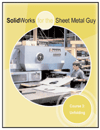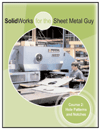Working with metal can be dangerous. Even with modern safety precautions, there were more than 1,100 reported nonfatal injuries in the metalworking industry in 2019 in the United States alone.
Heavy equipment, sharp metal and dangerous chemicals all pose potential threats to sheet metal contractors. Facility managers can mitigate these threats — but only if they know what to look for and which are most likely to harm workers.
1. Poor Workplace Ergonomics or Working Practices
Repetitive tasks and motions or even sudden exertions can cause musculoskeletal disorders (MSDs), also known as repetitive stress injuries (RSIs). MSDs are an umbrella of injuries that affect joints, muscles, tendons and nerves.
Improved workplace ergonomics can help prevent MSDs. Workers should also be trained on proper techniques and how to reduce awkward or particularly straining motions. Job rotation and task enlargement can also help avoid MSDs by decreasing the amount of time any employee spends on repetitive tasks.
2. Welding Incidents
Both the heat and light that welding produces are safety threats, potentially causing burns and eyesight damage.
Effective welding practices help to mitigate the risks associated with working with metal. Safety appeal — including gloves, shoes and proper eye protection for all workers in the area where welding takes place — and training for workers are essential.
3. Tool- and Machine-Related Injuries
Sheet metal contractors must be near dangerous heavy machinery. If tools aren’t used properly or if machines aren’t correctly guarded, the risk of injury can increase significantly.
All employees who work with or near metalworking equipment should be trained in its proper use, as well as potential safety hazards they should be aware of — like the potential for burns, exposure to toxic chemicals and cuts.
Keeping machines in top condition is also essential for preventing injury related to machine failure. Many businesses are also beginning to use predictive analytics in maintenance.
This predictive maintenance can also significantly reduce the cost of maintaining machines, helping make effective maintenance and safety precautions much more practical.
4. Chemical Hazards
Toxic or dangerous chemicals can present just as much a safety hazard as sharp metal or metalworking tools. Chemicals can cause injury when touched, inhaled or ingested. In enclosed, poorly ventilated areas, toxic fumes can pose a particularly significant threat.
Training and effective ventilation can reduce the risks chemicals may pose to metalworkers. Awareness of potential chemical threats is vital — all workers should be made aware of dangerous compounds they may be exposed to, like metalworking fluids or welding fumes.
Eliminating hazards by choosing safer chemicals can also reduce the potential danger. Some businesses use green welding techniques to make their manufacturing processes more sustainable — because they generate no fumes, they can lessen the chemical hazards workers may be exposed to.
5. Hearing Loss
Noise generated by metalworking can be extraordinarily loud — to the point where it can damage workers’ hearing within hours. Hearing loss cannot be reversed once it happens, and it can make it hard to hear warning signals or talk with others.
OSHA regulates the maximum amount of noise workers can be exposed to — 90 decibels with an eight-hour limit. Some states, like Washington state, have stricter limits.
Typically, if workers must raise their voice to talk to a co-worker an arm’s length away, noise levels are greater than 85 decibels. That’s more than some state limits and close to the OSHA-mandated maximum.










